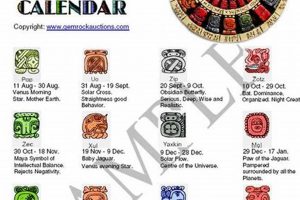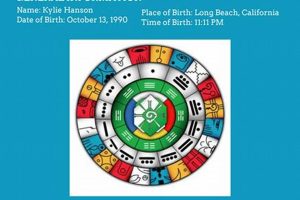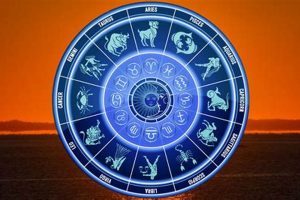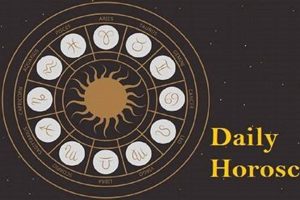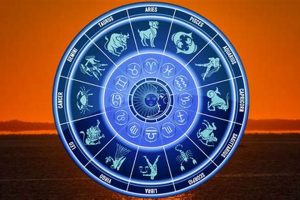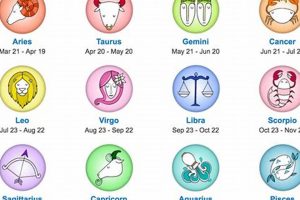The ancient Maya civilization developed a complex system of astrology based on a calendar distinct from the Gregorian calendar used today. This system utilizes a 260-day sacred calendar known as the Tzolk’in, combined with a 365-day solar calendar called the Haab’. Each day within these calendars corresponds to a specific energy and is associated with a unique combination of glyphs, numbers, and deities. These combinations form the basis for the cyclical patterns used to understand personality traits, predict events, and provide guidance for daily life.
For the Maya, this astrological framework served as a vital tool for navigating lifes journey. It offered a deep connection to the natural world and the cosmos, influencing decisions related to agriculture, ceremonies, and societal structures. By understanding the cyclical nature of time and the energies associated with each day, the Maya sought to live in harmony with the universe, achieving balance and purpose. Their understanding of these cycles provides valuable insights into their worldview and sophisticated knowledge of astronomy and mathematics.
This exploration delves deeper into the intricacies of the Tzolk’in and Haab’ calendars, examining the individual day signs and their associated meanings. Further sections will discuss the interplay between these calendars and how they combine to form a comprehensive system for understanding the Maya perspective on time, destiny, and the human experience.
Tips for Understanding and Applying Mayan Astrology
These tips offer practical guidance for incorporating Mayan astrological principles into daily life. They provide a starting point for deeper exploration and personal reflection.
Tip 1: Determine Your Day Sign: Begin by calculating your birth date according to the Tzolk’in calendar. Several online resources and books provide conversion tools. Understanding your day sign offers insights into your personality, strengths, and challenges.
Tip 2: Study the Tzolk’in Calendar: Familiarize yourself with the 20 day signs and the 13 numbers that make up the Tzolk’in. Each combination represents a unique energy imprint influencing daily life.
Tip 3: Explore the Haab’ Calendar: Learn about the 18 months and the 5 unlucky days of the Haab’ calendar. This solar calendar provides context for the agricultural and seasonal cycles relevant to Mayan cosmology.
Tip 4: Consider the Combined Calendars: The Calendar Round, formed by the intersection of the Tzolk’in and Haab’, provides a 52-year cycle. Understanding this longer cycle offers a broader perspective on personal development and recurring themes.
Tip 5: Reflect on Daily Energies: Consult resources that provide interpretations for the daily energies. Reflect on how these energies align with your experiences and use them to guide decision-making.
Tip 6: Consult with Experts: For a more in-depth understanding, consider consulting with Mayan elders, scholars, or practitioners who specialize in this complex system.
Tip 7: Respect the Tradition: Approach the study of Mayan astrology with respect and an open mind, recognizing its cultural and historical significance.
By understanding and applying these tips, individuals can gain valuable insights into themselves and the world around them, fostering a deeper connection to the wisdom of the ancient Maya.
This exploration provides a foundation for further study and personal reflection on the profound implications of Mayan astrology.
1. Tzolk'in Calendar
The Tzolk’in calendar serves as the foundation of Mayan astrology. This 260-day sacred calendar, distinct from the solar Haab’ calendar, plays a crucial role in determining individual destinies and understanding cyclical energies. Its intricate structure provides a framework for interpreting personality traits, predicting auspicious days, and guiding decision-making.
- 20 Day Signs:
The Tzolk’in comprises 20 unique day signs, each represented by a glyph and associated with specific characteristics and energies. These glyphs, such as Imix (creation), Ik’ (wind), and Ahau (sun), represent fundamental forces and archetypal energies within Mayan cosmology. Each day sign imbues individuals born on that day with distinct personality traits and predispositions.
- 13 Numbers:
Combined with the 20 day signs are the numbers 1 through 13, creating a continuous cycle. This numerical sequence interacts with the day signs, adding another layer of complexity to the interpretation. The number associated with a particular day influences the intensity and expression of the day sign’s energy. For example, 1 Imix represents a powerful surge of creative energy, while 7 Imix suggests a more introspective and nurturing approach to creation.
- Day Sign Combinations:
The interplay between the 20 day signs and the 13 numbers results in 260 unique combinations, each representing a specific energetic influence. These combinations repeat in a cyclical fashion, creating a framework for understanding the ebb and flow of energy in daily life. By understanding the specific combination for a given day, individuals can gain insights into the prevailing energies and align their actions accordingly.
- Divination and Prophecy:
The Tzolk’in calendar served as a powerful tool for divination and prophecy within Mayan culture. Priests and shamans utilized the calendar to determine auspicious days for ceremonies, agricultural activities, and important decisions. By understanding the energies associated with each day, they sought to harmonize with the natural world and ensure successful outcomes. The Tzolk’in remains a significant element in contemporary Mayan spiritual practices.
Understanding the Tzolk’in calendar is essential for interpreting Mayan astrology. Its intricate structure of day signs, numbers, and their combinations provides a complex framework for understanding personality, destiny, and the cyclical nature of time within Mayan cosmology. The Tzolk’in’s influence extends beyond individual interpretations, shaping communal rituals and providing a framework for understanding the interconnectedness of life within the Mayan worldview.
2. Haab' Calendar
The Haab’ calendar, the 365-day solar calendar used by the Maya, plays a significant role in their astrological system, complementing the sacred Tzolk’in calendar. While the Tzolk’in focuses on energetic cycles and personal destinies, the Haab’ anchors these energies within the context of the solar year and the agricultural cycle. This connection grounds the abstract principles of the Tzolk’in within the tangible realm of seasonal changes and the natural world.
The Haab’ consists of 18 months, each containing 20 days, followed by a five-day period known as Wayeb’. Each month possesses a unique name and associated glyph, reflecting agricultural practices or natural phenomena relevant to that time of year. For example, the month of Mol signifies the gathering of water, while Zip corresponds to the deer hunting season. These associations link the Haab’ directly to the practical aspects of Mayan life and the cyclical nature of their agricultural society. The Wayeb’ period, considered a time of transition and reflection, held particular significance, representing a period of vulnerability before the renewal of the solar year.
The interplay between the Tzolk’in and Haab’ calendars forms the Calendar Round, a 52-year cycle crucial for understanding long-term trends and influences within Mayan astrology. A specific date within this cycle will not repeat for 52 years. This cycle provides a framework for understanding recurring themes and predicting significant events, both on a personal and societal level. The correlation between the Haab’ and the solar year grounded Mayan astrological interpretations in the observable world, providing a practical framework for understanding the cyclical nature of time and its influence on human affairs.
3. Day Signs (glyphs)
Day signs, represented by glyphs, form the core of Mayan astrology. These 20 unique glyphs, each associated with specific energies and characteristics, function as archetypes within the Mayan cosmological system. They represent fundamental forces and principles that influence personality, destiny, and the cyclical nature of time. Each day sign contributes to the intricate tapestry of Mayan astrological interpretation, acting as a key component in understanding individual and collective experiences.
The influence of day signs extends beyond simple character descriptions. Consider the day sign Imix, associated with creation, nurturing, and new beginnings. An individual born on an Imix day might exhibit strong nurturing instincts, a connection to the natural world, and a penchant for initiating new projects. However, the specific expression of these traits depends on the accompanying number (1-13) and its position within the larger Calendar Round. For instance, 1 Imix suggests dynamic and outward-focused creative energy, while 7 Imix implies a more internalized and reflective approach to creation. By understanding the nuances of each day sign and its interactions within the calendar system, a richer and more nuanced understanding of individual and collective destinies emerges.
Understanding day signs provides a framework for interpreting the complexities of Mayan astrology. These glyphs represent not merely static symbols, but dynamic forces that interact with other elements of the calendar system to create a complex web of meaning. The practical application of this knowledge allows for deeper self-awareness, an understanding of recurring life patterns, and a greater appreciation for the interconnectedness of all things within the Mayan worldview. This knowledge can serve as a tool for personal growth, informed decision-making, and a deeper connection to the rich cultural heritage of the Maya civilization. While deciphering these intricate relationships requires dedicated study, the potential insights gained offer a profound understanding of the Mayan perspective on time, destiny, and the human experience.
4. Numbers (1-13)
Within Mayan astrology, the numbers 1 through 13 hold significant meaning, interacting with the day signs to create a complex system of energetic influences. These numbers are not merely quantitative but represent distinct energetic qualities that modify the characteristics of the day signs. They function as coefficients, amplifying or modulating the inherent energies of each day sign, providing a nuanced understanding of time and destiny.
- Energetic Coefficients:
Each number imbues a day sign with a specific energetic quality. For example, the number 1 represents beginnings, initiative, and independent action. When combined with a day sign like Imix (creation), 1 Imix signifies a potent surge of creative energy focused on new beginnings. Conversely, the number 7 represents reflection, introspection, and analysis. 7 Imix, therefore, suggests a more internalized and contemplative approach to creative processes.
- Cycles of Creation and Destruction:
The 13 numbers represent a cycle of creation, growth, and eventual dissolution, mirroring natural processes observed in the world around the Maya. This cyclical understanding of time informs the interpretation of the combined number and day sign. The ascending numbers (1-6) represent increasing energy and outward manifestation, while the descending numbers (7-13) suggest introspection, integration, and preparation for a new cycle.
- Interaction with Day Signs:
The interplay between the numbers and day signs is crucial for understanding the nuances of Mayan astrology. The number modifies the expression of the day sign’s energy. For instance, Ik’, the day sign representing wind, breath, and communication, takes on different characteristics depending on the accompanying number. 8 Ik’ might signify challenges in communication or scattered energy, whereas 3 Ik’ suggests inspired communication and the ability to connect with others effectively.
- The Trecena Cycle:
The 13 numbers also define the trecena, a 13-day period within the Tzolk’in calendar. Each trecena is ruled by a specific day sign and carries its own unique energy and themes. This further adds to the complexity and depth of Mayan astrological interpretation, providing a framework for understanding short-term cycles and influences within the larger 260-day cycle.
Understanding the significance of the numbers 1-13 is essential for interpreting the intricacies of Mayan astrology. These numbers, in conjunction with the day signs, form a complex system of energetic influences that provide insights into personality, destiny, and the cyclical nature of time. This system offers a framework for understanding both individual experiences and broader patterns within the Mayan worldview, highlighting the importance of numerical symbolism within their cosmological framework.
5. Deities & Associations
Mayan astrology integrates deities deeply into its interpretive framework. Each day sign within the Tzolk’in calendar connects with a specific deity, imbuing the sign with unique characteristics and influences. Understanding these divine associations provides essential context for interpreting the energies of each day sign and their impact on individual destinies. These deities represent forces of nature, cosmic principles, and aspects of human experience, adding depth and complexity to the astrological system.
- Patron Deities and Day Signs:
Each day sign possesses a patron deity who embodies the core principles and energies associated with that sign. For example, the day sign Imix connects with the creator deity Itzamn, associating it with beginnings, nurturing, and the primal forces of creation. Similarly, the day sign Ik’ associates with the wind god, often depicted as a bird, linking it to communication, intellect, and the power of breath. These associations provide a deeper understanding of the day sign’s inherent qualities.
- Influence on Personality and Destiny:
The associated deities influence the personality traits and life paths of individuals born under their corresponding day signs. Those born on an Imix day might exhibit qualities attributed to Itzamn, such as a nurturing nature, a strong connection to family, and a capacity for leadership. Similarly, individuals born on an Ik’ day might demonstrate strong communication skills, intellectual curiosity, and a capacity for adaptability, reflecting the attributes of the wind god.
- Offerings and Rituals:
Specific offerings and rituals honor the deities associated with each day sign. These practices aim to cultivate a harmonious relationship with the divine and seek blessings or guidance. For example, offerings associated with Imix might include maize, representing nourishment and abundance, while offerings to Ik’ could involve feathers or incense, symbolizing communication and the element of air.
- Interpreting Day Sign Combinations:
The combined influence of the day sign’s deity and the associated number creates a nuanced interpretation of the day’s energy. For instance, 1 Imix, combined with the energy of Itzamn and the number 1 (beginnings), signifies a powerful surge of creative potential. 7 Imix, however, suggests a more introspective and nurturing approach to creative endeavors. The deities provide a contextual framework for understanding the subtleties of these energetic combinations.
The integration of deities within Mayan astrology provides a rich and complex layer of meaning. These divine associations connect individuals to broader cosmological principles, offering insights into personality, destiny, and the cyclical nature of time within the Mayan worldview. Understanding these connections allows for a deeper appreciation of the spiritual significance embedded within the Mayan calendar system and its ongoing relevance in contemporary Mayan practices.
6. Calendar Round (52 years)
The Calendar Round, a cornerstone of Mayan timekeeping and astrology, represents a 52-year cycle created by the synchronization of the 260-day Tzolk’in and the 365-day Haab’ calendars. This cyclical interplay significantly influences Mayan astrological interpretations, providing a framework for understanding long-term patterns and individual destinies. The Calendar Round’s significance stems from the unique combination of energies generated by the interlocking of these two distinct calendar systems. Each day within the 52-year cycle possesses a unique energetic signature, derived from the specific combination of the Tzolk’in day sign and the Haab’ date. This intricate system provides a framework for understanding recurring themes and significant life events within a broader timeframe than the individual yearly cycles. A specific date, combining a particular Tzolk’in day sign with a Haab’ date, will not recur until the 52-year cycle completes. This cyclical repetition allows for the observation of long-term patterns and the prediction of potential challenges and opportunities based on the energies associated with specific points within the Calendar Round.
The implications of the Calendar Round extend beyond individual destinies, influencing communal rituals and societal cycles. Historically, the completion of a Calendar Round marked a significant event, often accompanied by elaborate ceremonies and the renewal of societal commitments. For example, the completion of a Calendar Round might prompt the construction of new temples or the reaffirmation of alliances between city-states. Understanding the Calendar Round provided a framework for societal planning and adaptation, aligning communal activities with the perceived cosmic cycles. Consider a hypothetical individual born on 1 Imix in the Haab’ month of Pop. This specific combination would not recur for 52 years, suggesting that significant life events or turning points might align with the completion of each Calendar Round. This understanding of cyclical time allowed the Maya to anticipate and prepare for potential challenges and opportunities, both individually and collectively.
The Calendar Round’s significance within Mayan astrology underscores the importance of cyclical time within their worldview. It serves as a complex tool for understanding destiny, societal patterns, and the interconnectedness of human experience with the cosmos. While the complexities of the Calendar Round require dedicated study, the potential insights gained offer a profound understanding of the Mayan perspective on time, fate, and the cyclical nature of existence. Challenges in interpreting the Calendar Round arise from the limited availability of complete historical records and the ongoing scholarly debate surrounding specific interpretations. Nevertheless, the Calendar Round remains a powerful lens through which to examine the rich tapestry of Mayan cosmology and its enduring legacy.
7. Personal Interpretations
Personal interpretations within Mayan astrology arise from the interplay of the Tzolk’in and Haab’ calendars, providing insights into individual characteristics, strengths, weaknesses, and life path. These interpretations offer a framework for self-discovery and understanding one’s place within the cosmos. By analyzing the day sign, associated number, and corresponding deity at birth, individuals can gain valuable perspectives on their inherent nature and potential life experiences.
- Personality Traits:
Each day sign carries specific personality traits. For instance, individuals born under the sign of Kan, associated with the maize god, often exhibit nurturing qualities, a grounded nature, and a strong connection to community. However, the influence of the accompanying number adds nuance. 4 Kan may signify a more pragmatic and detail-oriented approach to nurturing, whereas 12 Kan might suggest a broader, more philosophical approach to community engagement.
- Life Path and Destiny:
Mayan astrology offers insights into potential life paths and recurring themes. Understanding the energies associated with one’s birth date can illuminate potential challenges and opportunities. For example, individuals born under the sign of Oc, associated with leadership and independence, may encounter situations that call for these qualities. However, the specific manifestation of these traits depends on other factors within the Calendar Round and individual choices.
- Compatibility and Relationships:
Mayan astrology can illuminate interpersonal dynamics. Comparing day signs and their associated energies offers insights into potential strengths and challenges within relationships. For example, the combination of two individuals born under earth-related signs might suggest a stable and grounded partnership, whereas the pairing of a fire sign with a water sign might indicate a dynamic, potentially volatile relationship.
- Spiritual Growth and Self-Development:
By understanding the energies influencing one’s birth date, individuals can pursue spiritual growth and self-development. The insights gained through Mayan astrological interpretations can guide individuals towards practices and pursuits that align with their inherent strengths and address potential challenges. This awareness empowers individuals to navigate life with greater understanding and purpose. For instance, recognizing a predisposition towards introspection, as suggested by a birth date associated with the number 7, might encourage meditative practices or artistic expression.
Personal interpretations within Mayan astrology offer a framework for self-discovery and understanding one’s unique energetic blueprint. While these interpretations provide valuable insights, they should not be viewed as deterministic. Individual choices and external factors also play a crucial role in shaping life experiences. Mayan astrology offers a system for understanding potential influences, empowering individuals to navigate life with greater awareness and purpose within the cyclical context of Mayan cosmology.
Frequently Asked Questions
This section addresses common inquiries regarding the interpretation and application of Mayan astrology. The provided information aims to clarify potential misconceptions and offer a deeper understanding of this complex system.
Question 1: How does Mayan astrology differ from Western astrology?
Mayan astrology utilizes different calendars and interpretations than Western astrology. It emphasizes the cyclical nature of time, focusing on the interplay between the 260-day Tzolk’in and the 365-day Haab’ calendars. Western astrology primarily uses the Gregorian calendar and focuses on the positions of celestial bodies within the zodiac constellations. Both systems offer unique perspectives on personality and destiny, yet their underlying frameworks and interpretive methods differ significantly.
Question 2: What is the significance of the Calendar Round?
The Calendar Round, a 52-year cycle, represents the synchronization of the Tzolk’in and Haab’ calendars. A specific date within this cycle will not repeat for 52 years, providing a framework for understanding long-term patterns, recurring themes, and significant life events within Mayan cosmology.
Question 3: How can one determine their Mayan day sign?
Numerous online resources and printed materials offer conversion tools to determine one’s Mayan day sign based on the Gregorian birth date. These resources typically require inputting the birthdate to calculate the corresponding Tzolk’in day sign and its associated number.
Question 4: Are Mayan astrological interpretations deterministic?
Mayan astrological interpretations offer insights into potential personality traits, life paths, and recurring themes. However, they are not deterministic. Individual choices, external factors, and the complexities of human experience all contribute to shaping one’s destiny. Mayan astrology serves as a guide for understanding potential influences, not a fixed prediction of future events.
Question 5: How are Mayan deities incorporated into astrological interpretations?
Each day sign within the Tzolk’in calendar associates with a specific deity, imbuing the sign with symbolic meanings and influencing interpretations. These deities represent natural forces, cosmic principles, and aspects of human experience, adding depth and complexity to the astrological system. Understanding the characteristics of each deity provides further insights into the energies associated with individual day signs.
Question 6: What are the limitations of understanding ancient Mayan astrology today?
Scholarly understanding of ancient Mayan astrology faces limitations due to incomplete historical records and the complexities of interpreting ancient texts and practices. Ongoing research continues to refine interpretations, and variations in understanding exist among scholars and contemporary Mayan practitioners. Approaching these interpretations with an awareness of these limitations ensures a respectful and nuanced engagement with the subject matter.
This FAQ section provides a foundational understanding of Mayan astrology. Further research and exploration can enhance one’s comprehension of this intricate and culturally significant system.
The following sections offer additional details regarding specific aspects of Mayan astrological interpretation and practice.
Conclusion
This exploration has provided a comprehensive overview of Mayan astrology, encompassing its core components: the Tzolk’in and Haab’ calendars, the significance of day signs, numbers, and associated deities, and the implications of the Calendar Round. The intricate interplay of these elements offers a framework for understanding personality traits, potential life paths, and the cyclical nature of time within the Mayan worldview. The system’s complexity underscores the depth of Mayan astronomical and mathematical knowledge and its integration into their spiritual and cultural practices. By examining these individual components and their combined influence, a deeper appreciation emerges for the richness and sophistication of Mayan astrology.
Mayan astrology offers a unique perspective on the human experience, emphasizing the interconnectedness of individual destinies with the cosmos. While challenges remain in fully deciphering the intricacies of this ancient system, continued research and cross-cultural dialogue promise further insights into the Mayan understanding of time, fate, and the human condition. Further exploration of this fascinating system allows for a deeper understanding of Mayan culture and the enduring legacy of their sophisticated cosmological framework. The insights offered by Mayan astrology encourage reflection on the cyclical nature of life and the potential for aligning individual actions with broader cosmic patterns.


